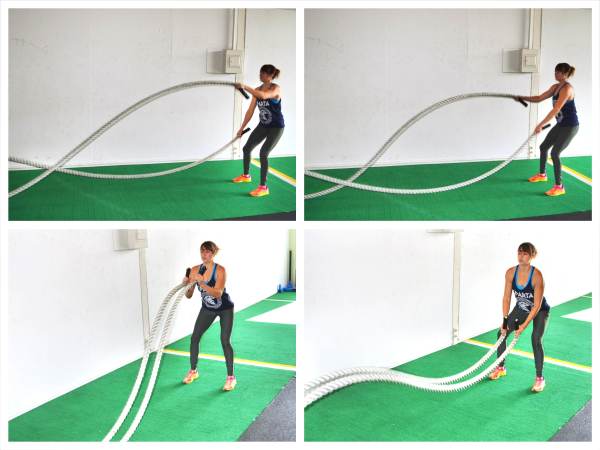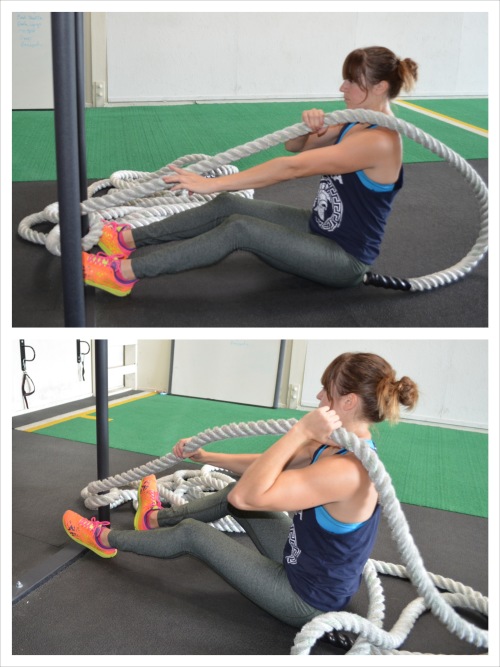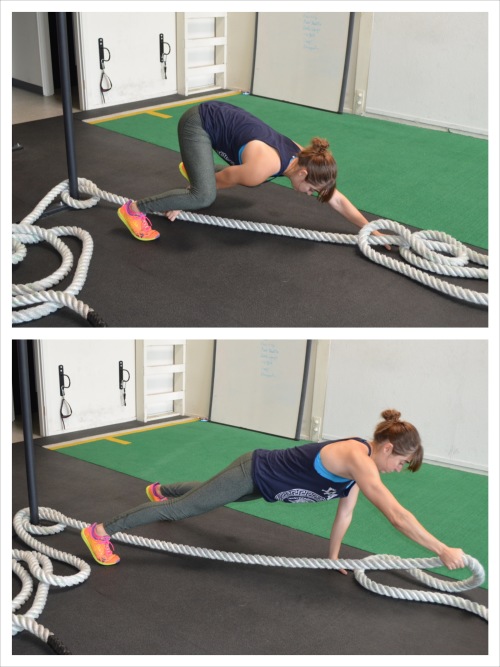Battling Ropes are a versatile training tool that you can use to work your entire body and improve your cardiovascular conditioning.
You can use the ropes to build an aerobic base, improve your lactic threshold or even increase your power.
At the same time that you can improve your cardiovascular conditioning, you can also develop functional full body strength.
There are two basic movements we do in our Battling Ropes Training – Waves and Pulls, which are drawn from John Brookfield’s Battling Ropes Training System.
The “wave” movement on battling ropes is an important part of our training program because it not only helps you develop greater power, but also helps you be able to maintain that power and intensity for a longer period of time.
Being able to go harder for longer? Who wouldn’t benefit from that!?!
Wave Movements
A few of the basic wave movements that we use are alternating arm waves, stage coach, outward circles, snakes, sidewinders and rainbows.

Alternating Arm Waves – Loop the rope around an anchor and hold one side in each hand. Pull the rope out straight then take a step or two in. Your arms can be straight or bent depending on which is more comfortable. Your feet should be about hip-width apart. You can be more in a squat or your legs can be straighter. Don’t be afraid to use your legs as you create waves and either move up and down with them together or slightly step one foot at a time. To create the waves, lift one arm up as you pull the rope down with the other. Then switch pulling one up and the other down. Alternate as quickly as possible using the legs as needed.
Stagecoach – Hold one side of the rope in each hand. Pull the rope out straight then take a step or two in. Hold the rope with the handles facing up. Your arms should be bent slightly and your feet should be about hip-width apart. Bend your knees slightly and then as you stand back up, pull up on the ropes with your arms. Then as you slam the rope back down, squat back down just a little. Move quickly, making small fast waves. Don’t worry about big slams. Keep your chest up and shoulders back as you create the waves. Don’t round forward or keep your legs locked out. Create as many waves as possible. As you advance, step forward closer to the anchor so there is more slack in the rope.
Sidewinders – Hold one side of the rope in each hand. Keep more slack in the rope than you would with other battling ropes moves. Relax your arms and stand with your feet between hip-width and shoulder-width apart. Then sweep your arms to the right, rotating through your core even pivoting a little up onto your left toes. Then quickly sweep your arms to the left. Sweep back and forth. Keep your arms more relaxed and only slightly bent. Use your core to push and pull from side to side. You shouldn’t do huge rotations. Your arms and the rope should stay out in front of you. The ropes should make snake-like waves on the ground and swish side to side. They should not move up and down off the ground.
Rainbows – Hold one side of the rope in each hand. Pull the rope out straight then take a step or two in. Hold the rope with the handles facing up. Keep your hands pretty close together. Rotate the handles outside your right hip and pivot your left leg. Then pull the rope up and then over toward your left hip. Pivot your right leg as you bring the rope to your left hip. Then arch back up bringing the rope up toward your shoulder than back down to your right hip. Keep pivoting and rotating the rope from hip to hip, arching up toward your shoulders as you bring the rope from one hip to another.
Snakes – Hold one side of the rope in each hand. Pull the rope out straight then take a step or two in. With your arms relaxed and slightly bent and your feet about hip-width apart, pull the ropes together and then pull them apart. The movement is almost like a chest fly with your arms hanging down. Move quickly creating “snakes” with the ropes on the ground. You can even use your legs to move quickly, squatting just a very little bit and then straightening your legs as you create the waves. Do not round your back. Keep your back flat even if you hinge over just a little.
Outward Circles – Loop the rope around an anchor and hold one side in each hand. Pull the rope out straight then take a step or two in. With your arms slightly bent, you are going to bend your knees slightly and then start to pull the ropes upward and outward. As you pull them up and out, stand back up. As you pull the rope down and around, squat a little back down and then explode back up as you pull the ropes back up and around. Use your legs to move quickly with the outward circles, pulling down around and then back up and in.
Wave exercises are generally done for time, but occasionally done for reps. We include both short intervals to work on power and longer intervals (up to 20 minutes) for endurance and aerobic work.
To make these wave exercises more full body, you can add in a lower body movement as you create the waves.
Side shuffles with alternating arms waves or backward lunges with stage coach or even walking forward and backward with sidewinders can not only make the movements harder and more full body but can also work on your coordination. Moving both hemispheres of the body in different ways at the same time can improve your mind-body connection. And as your mind-body connection improves, your coordination will improve – and better coordination is important for EVERYONE especially as we age!
All of the wave movements can be made easier or tougher by how far away from the anchor point you stand and the size of the rope you use.
When you first start out, you may also find your waves don’t go all the way down the rope. And that’s ok because as you get stronger, your waves will go further down. And once you get them easily all the way down you can use a bigger rope or take a few steps in!
No matter your fitness level, you can do Battling Ropes wave training!
Pull Movements

While the wave movements will make you stronger and allow you to push more intensely for longer, if you really want to focus on strength endurance, you need to include Battling Rope Pulls in your workout.
Rope pulls work on your upper body strength and endurance. Your muscles will not only get stronger, but you will be stronger for longer without fatiguing.
And if you have a desk job and are hunched over a computer screen for 9 hours a day, it is extra important that you include more “pulling” motions in your workout than “pushing” motions.
If you sit at a desk all day, you need to strengthen your back and opening up your chest, which is another reason Rope Pulls are included in our training.
Rope pulls can be done for time or for a length or two through the rope depending on the workout. They can be made harder or easier by the size of the rope used and how many wraps you do around the pole.
Just like the waves, pulls can be done by anyone at any level.

Battling Ropes Training is great for everyone from the beginner to the advanced exerciser because the movements are easy to learn and there is little risk of injury while using the ropes.
